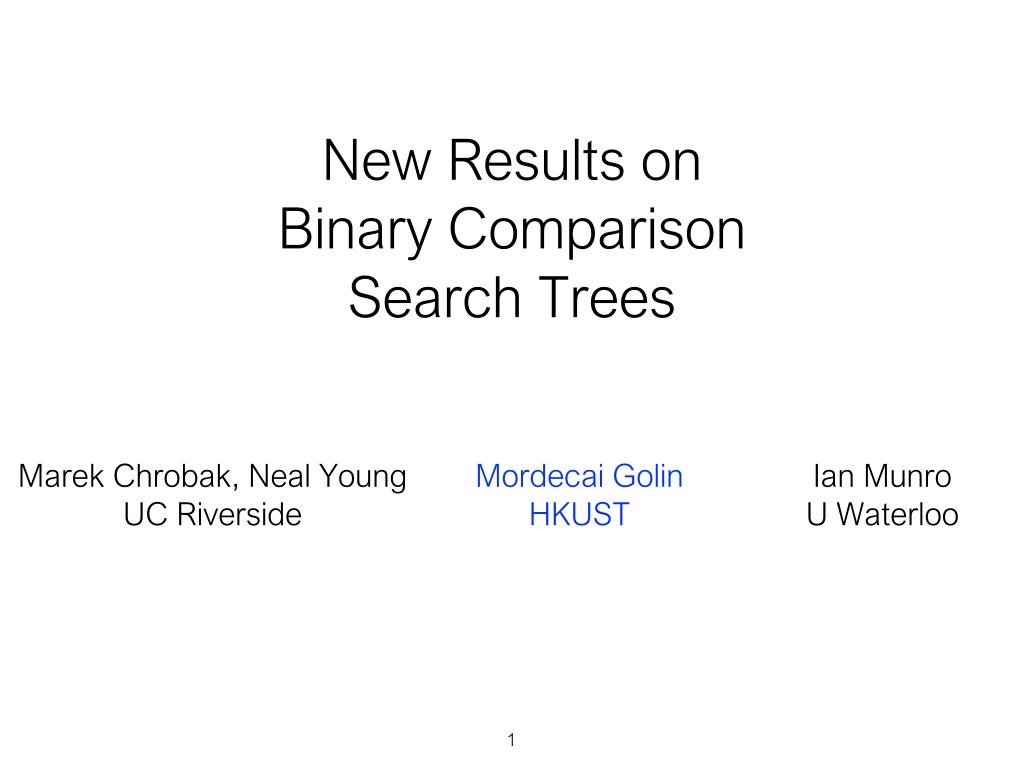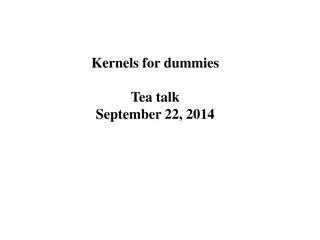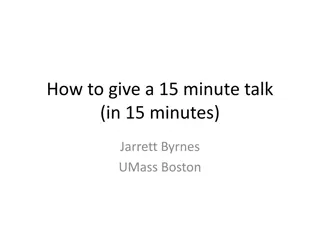
New Results on Binary Comparison Search Trees
Explore the latest findings on binary comparison search trees by Marek Chrobak, Neal Young, Mordecai Golin, and Ian Munro. Delve into optimal search trees, historical perspectives, and Knuth's optimal BST algorithm. Discover new insights into constructing min-cost trees and dynamic programming techniques for OBCSTs.
Download Presentation

Please find below an Image/Link to download the presentation.
The content on the website is provided AS IS for your information and personal use only. It may not be sold, licensed, or shared on other websites without obtaining consent from the author. If you encounter any issues during the download, it is possible that the publisher has removed the file from their server.
You are allowed to download the files provided on this website for personal or commercial use, subject to the condition that they are used lawfully. All files are the property of their respective owners.
The content on the website is provided AS IS for your information and personal use only. It may not be sold, licensed, or shared on other websites without obtaining consent from the author.
E N D
Presentation Transcript
New Results on Binary Comparison Search Trees Marek Chrobak, Neal Young UC Riverside Mordecai Golin HKUST Ian Munro U Waterloo 1
Early version of paper at arxiv.org Optimal search trees with 2-way comparisons Marek Chrobak, Mordecai Golin, J. Ian Munro, Neal E. Young arXiv:1505.00357 2
Main Result Constructing Min-Cost Binary Comparison Search Trees Wasn t this completely understood 45 years ago??!! Yes and No 3
Outline History Binary Search Trees Hu-Tucker Trees AKKL Trees Optimal Binary Comparison Search Trees with Failures Problem Models List of New Results New Results The Main Lemma Structural Properties of OBCSTs Dynamic Programming for OBCSTs Proof of The Main Lemma (Sketch) Extensions and Open Problems 4
Knuths Optimal BSTs Knuth [1971] gave algorithm for constructing Optimal Binary Search Trees Known: n keys K1, K2, ., Kn. Preprocess keys to create binary tree. Tree query compares query value Q to keys. and returns appropriate response from i such that Q = Ki i such that Ki < Q < Ki+1 Q < K1 or Kn < Q Input: probability of successful and unsuccessful searches 5
Knuths Optimal BSTs Knuth [1971] gave algorithm for constructing Optimal Binary Search Trees Input was probability of successful and unsuccessful searches Cost of tree was average path length Dynamic Programming Algorithm Constructed O(n^2) DP table Knuth reduced O(n^3) running time to O(n^2) Technique later generalized as Quadrangle Inequality method by F. Yao 7
Knuths Optimal BSTs Cost = 0.85 Cost = 1.10 Cost = 0.80 Cost = 1.05 8
Hu-Tucker Binary Comparison Search Trees Knuth constructed optimal binary search trees Trees structure was binary but nodes used ternary comparisons. Each node needed two binary comparisons to implement the search In a binary comparison search tree, each internal node performs only one comparison. Searches all terminate at leaves. First such trees constructed by Hu-Tucker, also in 1971. O(n log n) 9
Hu-Tucker Binary Comparison Search Trees Hu Tucker (1971) & Garsia-Wachs (1977) Assumes all searches are successful; no failures allowed. Input is only 1, 2, , n, with no i s. Internal nodes are < comparisons. Searches all terminate at leaves Problem is to find tree with minimum weighted (average) external path length O(n log n) algorithm 10
Outline History Binary Search Trees Hu-Tucker Trees AKKL Trees Optimal Binary Comparison Search Trees with Failures Problem Models List of New Results New Results The Main Lemma Structural Properties of OBCSTs Dynamic Programming for OBCSTs Proof of The Main Lemma (Sketch) Extensions and Open Problems 11
Adding Equality Comparisons The Knuth trees use three-way comparisons at each node. These are implemented in modern machines using two two-way comparisons (one Hu-Tucker trees use only one two-way comparison (a <) at each node. . . . machines that cannot make three-way comparisons at once. . . will have to make two comparisons. . . it may well be best to have a binary tree whose internal nodes specify either an equality test or a less-than test but not both. D. E. Knuth. The Art of Computer Programming, Volume 3: Sorting and Searching. Addison-Wesley, 2nd edition, 1998. [ 6.2.2 ex. 33], 12
Adding Equality Comparisons: AKKL[2001] Hu-Tucker Tree AKKL Tree AKKL trees are min cost trees with more power. instead of being restricted to be <, comparisons can be = OR < AKKL trees include HT Trees AKKL trees can be cheaper than HT Trees if some i much larger than others AKKL trees more difficult to construct 13
Adding Equality Comparisons: AKKL[2001] Anderson, Kannan, Karloff, Ladner [2002] extended Hu-Tucker by allowing = comparisons. AKKL find min-cost tree when the n-1 internal node comparisons are allowed to be in {=,<}. Useful when some i are very large (relatively) AKKL algorithm runs in O(n4) time. AKKL note this improves running time of O(n5) claimed by Spuler [1994] in his thesis Spuler only states O(n5) algorithm but doesn t prove that it produces optimal tree, so AKKL is really first polynomial time algorithm Reason problem is difficult is that equality nodes can create holes in ranges. This could dramatically (exponentially?) increase search space, destroying DP approach AKKL show that if equality comparison exists, then it is always largest probability in range. Allows recovering DP approach with ranges of description size O(n3) (compared to Knuth s O(n2)) 14
Adding Equality Comparisons: AKKL[2001] Hu-Tucker Tree AKKL Tree Comment 1 : Other problem in AKKL is how to deal with repeated weights This was hardest part. Comment 2: Both Hu-Tucker and AKKL only work when failures don t occur. I.e., only iare allowed and not i. 15
So Far + Obvious Open Problem Optimal Binary Search Trees Input: O(n2) Knuth Optimal Binary Comparison Search Trees Input: C = {<}: O(n logn) Hu-Tucker & Garsia-Wachs C = {=,<}: O(n4) AKKL Obvious Questions Can we build OBCSTs that allow failures? If yes, for which sets of comparisons? Answer is yes, (for all sets of comparisons) but first need to define problem models 16
Outline History Binary Search Trees Hu-Tucker Trees AKKL Trees Optimal Binary Comparison Search Trees with Failures Problem Models List of New Results New Results The Main Lemma Structural Properties of OBCSTs Dynamic Programming for OBCSTs Proof of The Main Lemma (Sketch) Extensions and Open Problems 17
BCSTs with Failure Probabilities Allows Failures ( iand i). Call this complete input. HT has restricted input. Tree for n keys has 2n+1 leaves Distinguishing between Q==Ki and Ki < Q < Ki+1 always requires querying (Q=Ki) 18
Using Different Types of Comparisons Left Tree uses {<,=}. Right Tree uses {<, , =} Minimum cost BCST is minimum taken over all trees using given set of comparisons C, e.g., C={<,=} or C={<, , =} C is input to the problem. Algorithm is different for different Cs. 19
How Much Information is Needed for Failure? Comparisons Tree on left shows Explicit Failure every failure leaf reports unique failure interval, Ki < Q < Ki+1. Tree on right shows Non-Explicit Failure: Failure leaves only report failure. Don t need to specify exact interval. Leaf can be concatenation of successive failure intervals . 20
New Algorithms: OBCSTs with Failures FFFailueComparisons DP Algorithms for last 4 cases are very similar Differ slightly in Design of Recurrence Relations {=,<} and {=,<, ) yield slightly different recurrences Initial conditions Explicit and Non-Explicit Failures force different I.C.s 21
Outline History Binary Search Trees Hu-Tucker Trees AKKL Trees Optimal Binary Comparison Search Trees with Failures Problem Models List of New Results New Results The Main Lemma Structural Properties of OBCSTs Dynamic Programming for OBCSTs Proof of The Main Lemma (Sketch) Extensions and Open Problems 22
Main Lemma: Lemma Let T be a Optimal BCST. If (Q=Kk) is a Descendant of (Q=Ki) Then k i Note: This is true regardless of which inequality comparisons are used and which model BCST is used Corollary: If T is an OBCST and (Q=Kk) an internal node in T, then i.e., equality weights decrease walking down the tree 23
Outline History Binary Search Trees Hu-Tucker Trees AKKL Trees Optimal Binary Comparison Search Trees with Failures Problem Models List of New Results New Results The Main Lemma Structural Properties of OBCSTs Dynamic Programming for OBCSTs Proof of The Main Lemma (Sketch) Extensions and Open Problems 24
Structural Properties of BCSTs Henceforth assume distinct key weights, i.e., all of the 1, 2, , n are different Also assume C={<,=} [- , ) Every tree node N corresponds to search range of subtree rooted at N [- ,C) [C, ) [- ,C)-{B} Root of BSCT is search range [K0,Kn+1) (where K0=- and Kn+1= ) Comparisons cuts ranges A (Q<Ki) splits [Ki,Kj) into [Ki,Kk) and [Kk,Ki) [C,D) [D, ) [- ,C)-{A,B} [A,C)-{A,B} A (Q=Ki) removing Ki from range, Range of subtree rooted at N is some [Ki,Kj) with some keys removed Keys removed (holes) are Kk s.t. (Q=Kk) is on the path from N to the root of T. 25
Structural Properties of OBCSTs Range associated with Node N is [Ki,Kj) with some (h) keys Kk removed. Kk removed are s.t. (Q=Kk) are equality nodes on path from N to root (that fall within [Ki,Kj)) From previous Lemma, if T is an OBCST, i of nodes path to N are larger than iof all equality nodes in T . k, (Q=Kk) appears somewhere in T. Immediately implies that the h missing keys must be the largest weighted keys in [Ki,Kj) Define punctured range [i,j: h) to be range [Ki,Kj) with the h highest weighted keys in [Ki,Kj) removed => every range associated with an internal node of an OBCST is a punctured range 26
Structural Properties of OBCSTs [i,j: h) is range [Ki,Kj) with the h highest weighted keys in [Ki,Kj) removed [0,n+1:0) Range associated with an internal node of an OBCST is some [i,j: h) Define OPT(i,j: h) to be the cost of an optimal BCST for range [i,j: h) Goal is to find OPT(0,n+1: 0) and associated tree [i,j:h) Will use Dynamic programming to fill in table. Table has size O(n3) We will (recursively) evaluate OPT(i,j: h) in O(j- i) time, yielding a O(n4) algorithm. 27
Outline History Binary Search Trees Hu-Tucker Trees AKKL Trees Optimal Binary Comparison Search Trees with Failures Problem Models List of New Results New Results The Main Lemma Structural Properties of OBCSTs Dynamic Programming for OBCSTs Proof of The Main Lemma (Sketch) Extensions and Open Problems 28
Dynamic programming for OBCSTs Let T be an OBCST for [i,j: h) T Has two possible structures 1. Root is a (Q=Kk) 2. Root is a (Q<Kk) 29
Dynamic programing for OBCSTs 1. Root of OPT(i,j: h) is a (Q=Kk) Kk must be largest key weight in [i,j: h) which is (h+1)st largest key weight in [i,j) Right subtree missing h+1 largest weights in [i,j) so right subtree is OPT(i,j: h+1) Cost of full tree is sum of cost of left subtree 0 cost of right subtree OPT(i,j: h+1) Total weight of left + right subtree Wi,j:h where Wi,j:h = sum of all i, i in (i,j: h] 30
Dynamic programing for OBCSTs 2. Root of OPT(i,j: h) is a (Q<Kk) Range is split into <k and k h holes (largest keys) in [i,j) are split, with h1(k) on left and h2(k) =h-h1(k) on right h1(k) keys must be heaviest in [i,k) h2(k) keys must be heaviest in [k,j) So left and right subtrees are OBCSTs for [i,k: h1(k)) and [k,j: h2(k)) Cost of tree is Wi,j:h + OPT(i,k: h1(k)+ OPT(k,j: h2(k)) Don t know what k is, so minimize over all possible k 31
Dynamic programing for OBCSTs OPT(i,j: h) has two possible structures 1. Root is a (Q=Kk) 2. Root is a (Q<Kk) This immediately implies But every case seen can construct a BCST with that cost, so 32
Dynamic programing for OBCSTs Set initial conditions for ranges OPT(i,i+1,*) OPT(i,i+1,1)=0 OPT(i,i+1,0)= i + i Comments Must restrict h j-i (can t have more holes than keys in interval) Need to fill in table in proper order, e.g., (a) d= 0 to n, (b) i=0 to n-d, j=i+d+1, (c) h =(j-i) downto 0 Need O(1) method for computing hi(k) => O(j-i) to calculate OPT(i,j: h) => O(n^4) to fill in complete table OPT(0,n+1:0) is optimal cost. Use standard DP backtracking to construct corresponding optimal tree 33
Perturbing for Key Weight Uniqueness (I) Strongly used assumption i are all distinct to find `weightiest keys Assumption can be removed using perturbation argument All values constructed/compared in algorithm are subtree costs in form ai i + bi i where 0 ai,bi 2n are integral node depths Perturb input by setting i= i, i = i+i? ? where ? is very small => i are all distinct Since i are all distinct, algorithm gives correct result for i , i Easy to prove that optimum tree for i , iis optimum for i , i => resulting tree is optimum for original i , i In fact don t actually need to know value of ? 34
Perturbing for Key Weight Uniqueness (II) Perturb input: i= i, i = i+i? where ? is very small Need to find optimum tree for i , i (which is also optimum for i , i ) Recall that algorithm only performs additions/comparisons All values are subtree costs ai i + bi i where 0 ai,bi 2n are integral Don t actually need to know or store value of ? Every value in algorithm is in form x = x1+x2?, where x2=O(n3) is an integer Forget ?. Store pair (x1,x2) (A) Addition is pairwise-addition (x1,x2) + (y1,y2) = (x1+y1, x2+y2) (C) Comparison is lexicographic-comparison (x1,x2) < (y1,y2) iff x1<y1 or x1=y1 and x2=<y2 Both (A) and (C) can be implemented in O(1) time without knowing ? Perturbed algorithm has same asymptotic running time as regular one 35
Odds and Ends Designed O(n4) algorithm for constructing OBCSTs when C={<,=} and need to report Exact Failures Strongly used assumption i are all distinct Assumption can be removed using perturbation argument To solve problem C={<,=} with Non-Exact failures only need to modify initial conditions Symmetry argument gives algorithms for C={ , =} Algorithms for C={<, , =} requires only slight modifications of SPLIT(i,j: h) If C={<, }, ranges have no holes and problem can be solved in O(n log n) similar to Hu 36
Outline History Binary Search Trees Hu-Tucker Trees AKKL Trees Optimal Binary Comparison Search Trees with Failures Problem Models List of New Results New Results The Main Lemma Structural Properties of OBCSTs Dynamic Programming for OBCSTs Proof of The Main Lemma (Sketch) Extensions and Open Problems 37
Proof of Main Lemma Let T be an OBCST. Assume y<x (x>y is symmetric) (Q=x) is above (Q=y) => x< y will show contradiction => x y and Thm correct All comparisons between (Q=x) and (Q=y) are inequalities otherwise (Q=w) on path with either x< wor w< y and can show contradiction with (x,w) or (w,y) x,y Range((Q=x)) by definition If x,y Range((Q=y)) then could swap (Q=X) and (Q=y) to get cheaper tree. 38
Proof of Main Lemma Let T be an OBCST. Assume y<x (x>y is symmetric) (Q=x) is above (Q=y) => x< y will show contradiction All comparisons between (Q=x) and (Q=y) are inequalities Since x Range((Q=y) => Path (Q=x) to (Q=y) contains (Q<z) s.t z s children s ranges are [i,z,h ), [z,j,h ) where y [i,z) and x [z,j). z is called splitter. P is (red) path from (Q=x) to (Q=y) x would be here 39
Proof of Main Lemma P is path in T from (Q=x) to (Q=y). y< x. z is x-y splitter on P P is path from (Q=x) to (Q=z) Proof will be case analysis of structure of P For every P , will show can build cheaper OBCST T contradicting optimality of T Case 1: P is one edge y A => Weight(A) y> x => replacing left subtree by right subtree in T yields new BCST T with lower cost than T, contradicting T being OBCST 40
Proof of Main Lemma P is path in T from (Q=x) to (Q=y). y<x. z is x-y splitter on P P is path from (Q=x) to (Q=z) Case 2: P is two edges y A=> Weight(A) y> x => again replacing left tree by right tree in T yields new BCST T with lower cost than T, contradicting T being OBCST 41
Proof of Main Lemma P is path in T from (Q=x) to (Q=y). y<x. z is x-y splitter on P P is path from (Q=x) to (Q=z) Proof will be case analysis of structure of P Already saw first two cases of P Showed for each that assumptions allow replacing subtree rooted at (Q=x) with cheaper subtree for some range. Replacement leads to cheaper BCST, contradicting optimality of T The full proof splits P into 7 cases. For each, can show replacement with cheaper subtree, contradicting optimality of T. 42
Outline History Binary Search Trees Hu-Tucker Trees AKKL Trees Optimal Binary Comparison Search Trees with Failures Problem Models List of New Results Our Results The Main Lemma Structural Properties of OBCSTs Dynamic Programming for OBCSTs Proof of The Main Lemma Extensions and Open Problems 43
Extensions & Open Problems If the i, i are probabilities (sum to 1) can show an O(n) algorithm that constructs BCST within additive error 3 of optimal for Exact Failure Case Modification of similar algorithm for Hu-Tucker case. O(n4) is quite high for worst case. Can we do better? 44






















